Hunting Temples in the Ancient Laos Capital of Luang Prabang
PUBLISHED December 7th, 2017 06:00 am | UPDATED February 2nd, 2018 04:00 am
While the quiet town of Luang Prabang in Laos is rapidly barrelling towards tourist territory, you cannot doubt the cultural splendour and inherent natural charm lent out by the many ancient temples, or wats, in the vicinity – 34 of them, to be exact. Spend a single day there and you’ll notice the large monk community, for even amongst Asia and the Buddhist-majority Laos, this UNESCO World Heritage Site is especially renowned for its fervent spirituality.
In collaboration with SilkAir, we grabbed a map and went around exploring these sacred structures, many of them still active and home to over 1,000 novices and monks.
Wat Xieng Thong
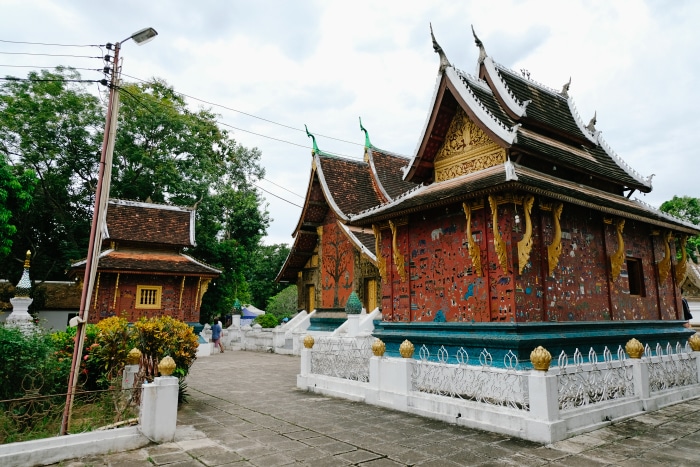
Why not start with the most famous of them all? Wat Xieng Thong, built in 1560 and found right on the tip of the old town peninsula, is the most significant temple in Luang Prabang. Patronised by the royal family during the Kingdom of Laos, you’ll find several small halls and stupas – extensively decorated with gold stencilling on black and red lacquer and colourful mosaics – that contain Buddha images of the period, a rare reclining Buddha sanctuary, the Tripitaka Library, and a 12-metre high funeral carriage with various urns for members of the royal family.
Admission: 20,000 kip, US$2.40
Opening hours: 8am – 5pm
Where: Between Khem Khong Rd and Sakkaline Rd
Wat Nong Sikhounmuang
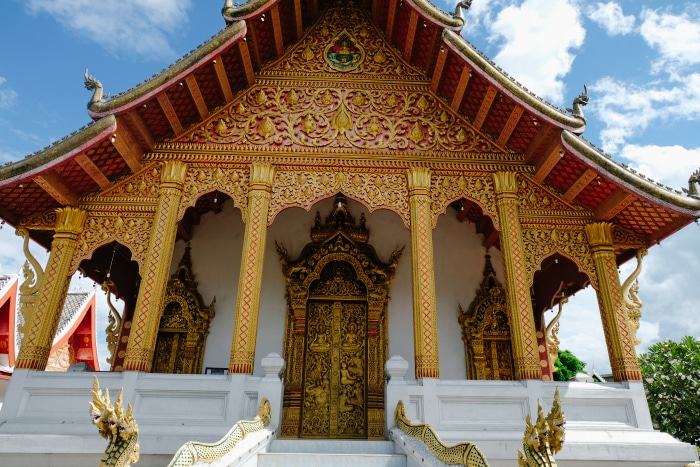
While the massive Wat Nong Sikhounmuang was originally built in 1729, the temple was later badly damaged in a fire in 1774, leaving a legendary statue of the Buddha (called Pra Chao Ong Saensaksid) as the sole surviving object. Now, the temple has since been rebuilt to rehouse the bronze statue and features a dazzling three-tier coloured roof, which resembles Bangkok’s Thai-style temples.
Admission: By donation
Opening hours: 8am – 5pm
Where: Kounxoa Rd
Wat Wisunarat
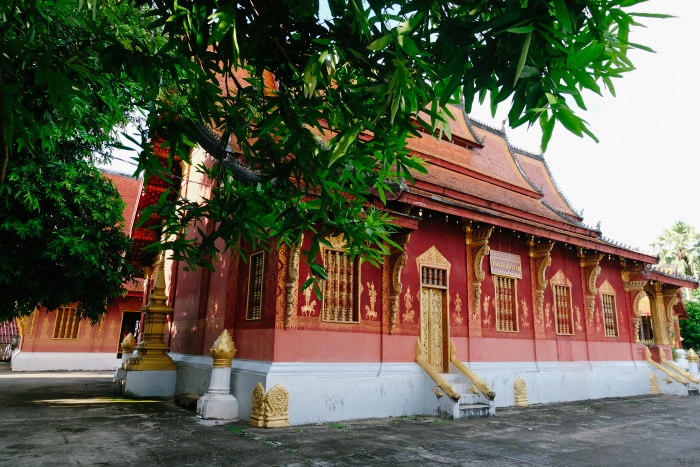
Wat Wisunarat is the town’s oldest temple, built in 1503 and once home to the Prabang Buddha. Following the raid (and destruction) by the Chinese Black Flag Army in 1887, it was rebuilt using stucco and brick and now acts as the Museum of Religious Arts, housing an array of religious artefacts and precious items related to Buddhism, such as gilded Buddhas and ancient stones. It also features a unique lotus flower-shaped stupa, though the locals refer to it as the ‘watermelon stupa’.
Admission: 5,000 kip, US$0.60
Opening hours: 8am – 5pm
Where: Th Wisunarat
Wat Mai
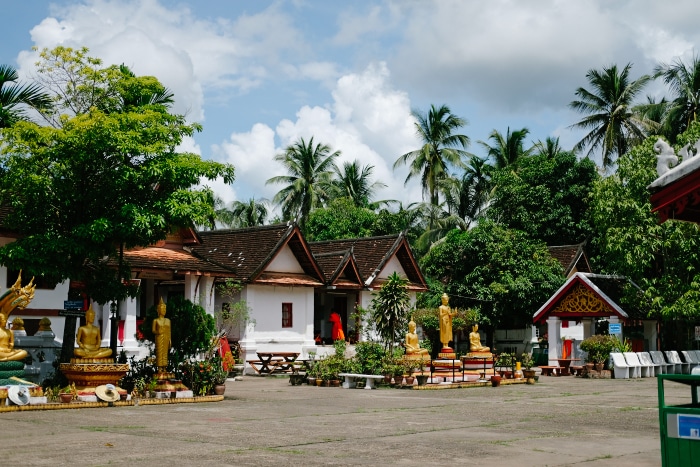
With its distinct five-tiered roof adorned with black and red lacquer, expansive compound, and prime location on the main street, Wat Mai is impossible to miss. Relatively unchanged since its completion in the late 18th century, there are two small stone chapels and a drum tower beside the gilded main hall, as well as a boathouse storing long racing boats used during the town’s annual boat festival.
Admission: 10,000 kip, US$1.20
Opening hours: 8am – 5pm
Where: Sisavangvong Rd
Wat Mahathat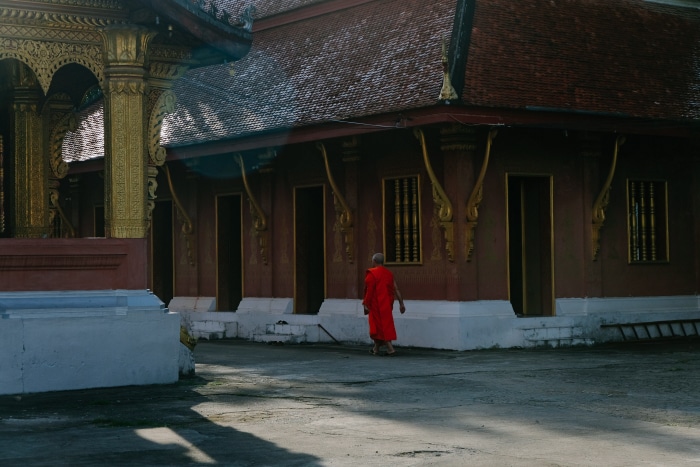
The ‘Temple of the Great Stupa’ located next to the Mekong River is one of the more ornate temples in Luang Prabang. First built in 1548, you’ll find a magnificent staircase flanked by the mythical Naga serpents that lead to the temple grounds. Then, look out for two statues of Phrae Mae Thorani, the Earth Goddess from Buddhist lore. During the Laos new year celebrations, monks from several temples will walk in procession here to perform a dance for Pu No and Na No, the city’s guardian spirits.
Admission: 5,000 kip, US$0.60
Opening hours: 8am – 5pm
Where: Chao Fa Ngum Rd
Wat Chom Si
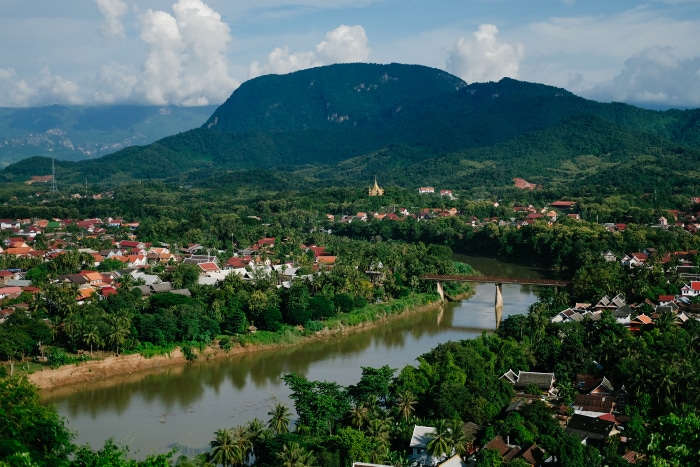
Chances are you might be visiting this place unknowingly. Located on top of the famous Phousi Hill is Wat Chom Si with a golden pagoda (and seven-tier parasol) that overlooks Luang Prabang and the Mekong river. It’s a popular spot in town and not just for the view – next to the stupa is a small vihara shrine with a seated Buddha surrounded by smaller ones.
Admission: 20,000 kip (for Phousi Hill), US$2.40
Opening hours: 6am onwards
Where: Phousi Hill
Wat Chomphet
For something a little more off the beaten track, the temples across the Mekong River are worth a visit. From the boat docks behind the Royal Palace Museum, look for someone to take you across (around 5, 000 kip per person) to the other side, then walk up river, through the small village, and up a lengthy flight of stairs (123 steps) to find Wat Chomphet. The modest building dates back to 1888 and houses several novices, and is best known for its panoramic view of the surrounding hills and Luang Prabang.
Admission: 10,000 kip, US$1.20
Opening hours: 8am – 5pm
Where: Luang Prabang
Wat Long Khoun
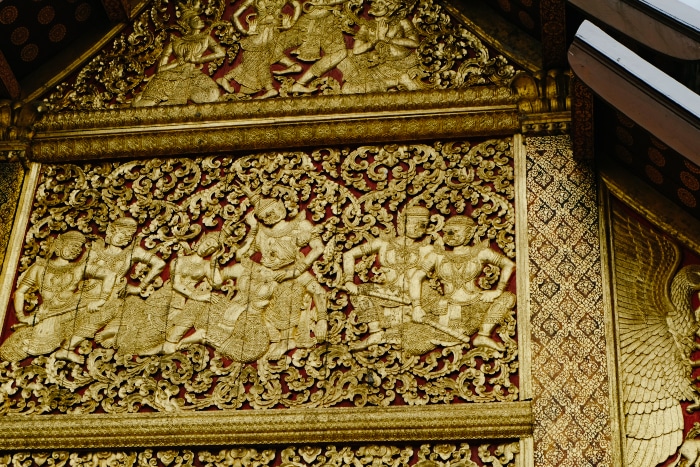
Also on the other side of the Mekong, you can continue along the path to Wat Long Khoune to see fascinating statues of Chinese guardians at the entrance. Once sanctuary to new kings seeking spiritual rejuvenation, you’ll find the original meditation room still intact, as well as the wood living quarters for monks. The temple’s interior features elegant black-and-gold columns and a red ceiling with intricate carvings of dharma wheels, peacocks, and mythical creatures.
Admission: 10,000 kip, US$1.20
Opening hours: 8am – 5pm
Where: Luang Prabang
Wat Tham Xieng Maen
This temple is a short distance away from Wat Long Khoun, and unlike the other temples on this list, Wat Tham Xing Maen is no longer active. Be sure to enquire at the former to get someone to unlock the gate, and proceed to explore the 100m deep limestone cave (bring a torchlight) that houses the temple and two large spirit houses.
Admission: 5,000 kip, US$0.60
Opening hours: 8am – 5pm
Where: Luang Prabang
Wat Sop Sickharam
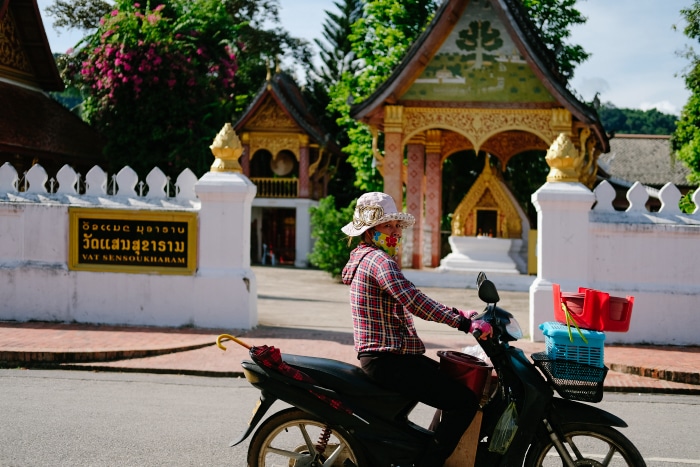
Marked by a blue-green glazed stupa right by the entrance, there are plenty of lanterns hung from the boundaries to the gorgeous main hall, nicely decorated with intricate art and drawings. There is also a school for novices, who will drum and chant up a storm in the late afternoon as the sound rolls across the complex like waves.
Admission: By donation
Opening hours: 8am – 5pm
Where: Sakkaline Rd
General etiquette for visiting temples
- As with temples in other parts of Southeast Asia, do cover up bare shoulders or legs when entering the temple compound. Some temples rent out traditional sarongs to cover up for a small fee.
- When inside the temple buildings and ordination halls, remove your sunglasses and hat as a show of respect, and avoid touching any of the relics unless you are invited to do so.
- Needless to say, maintain a respectful silence and keep your comments to yourself until outside the building.
- Avoid getting up close to monks and stuffing a camera in their face. Always ask first for permission first, when in doubt. The same goes for any ceremonies going on in the temple complex. You wouldn’t want strangers taking your relative’s funeral as a photo-op, would you?
SilkAir, the regional wing of Singapore Airlines, currently operates about 400 flights a week to 53 destinations in 16 countries. The destinations SilkAir operates to are within a six-and-a-half-hours flying duration from Singapore, with the furthest destination being Cairns in Australia. Come October 31st, SilkAir will be operating to its newest destination, Hiroshima, Japan. At the moment, the combined Singapore Airlines and SilkAir network covers over 100 destinations in 36 countries.
SilkAir’s positioning as a premium, short-to-medium haul regional carrier gives it a unique appeal amongst leisure and business travellers in Asia. Whilst offering carefully selected meals, a full bar service and complimentary inflight entertainment, SilkAir places great emphasis on providing attentive, friendly and relaxing service. The carrier’s regional flair is expressed through both its cabin crew and its cuisine – ensuring that your experience of the destination you’re heading to begins when you step onto our plane.
For more information on flights to Luang Prabang, find out here.
